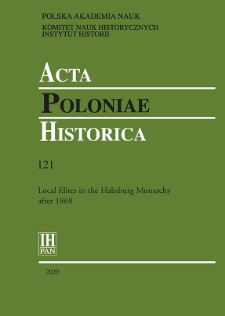- Search in all Repository
- Literature and maps
- Archeology
- Mills database
- Natural sciences
Advanced search
Advanced search
Advanced search
Advanced search
Advanced search

Object
Title: The ‘Kindred Circle’ of Village Mayors in the Habsburg Monarchy and the Example of Cieszyn Silesia, 1864–1918
Subtitle:
Acta Poloniae Historica T. 121 (2020) ; Local Elites in the Habsburg Monarchy after 1868
Institutional creator:
Polska Akademia Nauk. Komitet Nauk Historycznych
;
Polska Akademia Nauk. Instytut Historii im. Tadeusza Manteuffla
![]()
Contributor:
Polska Akademia Nauk. Komitet Nauk Historycznych ; Polska Akademia Nauk. Instytut Historii im. Tadeusza Manteuffla
Publisher:
Place of publishing:
Description:
Type of object:
Abstract:
In Cieszyn Silesia (the eastern part of the crownland of Austrian Silesia) from the time local government was introduced in 1864 until 1918 it is possible to identify 1332 village mayors (German: Gemeindevorsteher; Polish: wójt; Czech: starosta). Of these, at least 1006 (almost 76 per cent) had another village mayor in Cieszyn Silesia in their ‘kindred circle’, which includes second-degree relatives according to canonical computation, as well as witnesses at weddings and baptisms of their closest family (children, parents, siblings). The uninterrupted lineage of these types of relationships connected at least 875 village mayors, or 66 per cent of all those known. Thus the partial democratisation at the level of local self-government led to a kind of oligarchy, with the position of the village head being assumed by wealthy peasant families who all had connections to one another. Outside of the ‘kindred circle’, there were the factory owners and officials of archdukes and counts, who took the position of village mayor in industrialised areas, as well as a few Jewish village mayors and probably the majority of village mayors from the mountain villages. The question examined here is whether the situation looked similar in other parts of the Habsburg monarchy, or whether Cieszyn Silesia stood out in this respect. This question remains unanswered due to the lack of analogous studies on village mayors.
References:
Kasprzykiewicz Josef, Landesgezetze für Schlesien, i (Teschen, 1870)
Minakowski Marek, ‘Gęstość sieci koligacji w parafii Kampinos’, Przeszłość Demograficzna Polski, xxv (2014), 65–74
Mitchell William E., ‘Theoretical Problems in the Concept of Kindred’, American Anthropologist, lxv, 2 (1963), 343–54
Morys-Twarowski Michael, ‘The Relationship between Religion, Language and Nationality on the Example of Village Mayors in Cieszyn Silesia in 1864–1918’, Historie – Otázky – Problémy, x, 2 (2018)
Morys-Twarowski Michael, Wójtowie na Śląsku Cieszyńskim 1864–1918. Studium prozopograficzne, 3 vols. (Kraków, 2018)
Nowak Krzysztof, ‘Życie polityczne i społeczne’, in Idzi Panic (ed.), Ustroń 1305– 2005, i (Ustroń, 2005)
Pilch Józef, ‘130 lat samorządu wsi, osiedla, miasta Ustronia’, Pamiętnik Ustroński, vi (1993)
Šústková Hana, ‘Nobilitovaní příslušníci slezského zemského sněmu v letech 1861–1918’, Historica – Revue pro historii a příbuznévědy, 14 (2017), 263–83
Relation:
Acta Poloniae Historica ; Acta Poloniae Historica
Volume:
Start page:
End page:
Detailed Resource Type:
Format:
Resource Identifier:
oai:rcin.org.pl:138255 ; 0001-6829 ; 2450-8462 ; 10.12775/APH.2020.121.02
Source:
IH PAN, sygn. A.295/121 Podr. ; IH PAN, sygn. A.296/121 ; click here to follow the link
Language:
Rights:
Creative Commons Attribution BY-ND 4.0 license
Terms of use:
Copyright-protected material. [CC BY-ND 4.0] May be used within the scope specified in Creative Commons Attribution BY-ND 4.0 license, full text available at: ; -
Digitizing institution:
Institute of History of the Polish Academy of Sciences
Original in:
Library of the Institute of History PAS
Projects co-financed by:
National Programme for the Development of the Humanities
Access:
Object collections:
- Digital Repository of Scientific Institutes > Partners' collections > Institute of History PAS > Serials
- Digital Repository of Scientific Institutes > Partners' collections > Institute of History PAS > Institute Publications
- Digital Repository of Scientific Institutes > Partners' collections > Institute of History PAS > Institute Publications > Journals
- Digital Repository of Scientific Institutes > Partners' collections > Institute of History PAS > Institute Publications > Journals > Acta Poloniae Historica
- Digital Repository of Scientific Institutes > Literature > Journals/Articles
Last modified:
Feb 5, 2025
In our library since:
Sep 8, 2020
Number of object content downloads / hits:
175
All available object's versions:
https://rcin.org.pl./publication/173006
Show description in RDF format:
Show description in RDFa format:
Show description in OAI-PMH format:
Objects Similar
Morys-Twarowski, Michael
Kamiński, Marek Kazimierz (1948–2020)
Marcoń, Witold (1962– )
Gąsior, Grzegorz (1980– )
Trajdos, Tadeusz Mikołaj (1951– )
Sikora, Wincenty (1878–1958)
Brafman, Âkov Aleksandrovič (1825–1879)
Mazur, Marcin (1982– ) Czapiewski, Konrad Ł Janc, Krzysztof Konopski, Michał

 INSTYTUT ARCHEOLOGII I ETNOLOGII POLSKIEJ AKADEMII NAUK
INSTYTUT ARCHEOLOGII I ETNOLOGII POLSKIEJ AKADEMII NAUK
 INSTYTUT BADAŃ LITERACKICH POLSKIEJ AKADEMII NAUK
INSTYTUT BADAŃ LITERACKICH POLSKIEJ AKADEMII NAUK
 INSTYTUT BADAWCZY LEŚNICTWA
INSTYTUT BADAWCZY LEŚNICTWA
 INSTYTUT BIOLOGII DOŚWIADCZALNEJ IM. MARCELEGO NENCKIEGO POLSKIEJ AKADEMII NAUK
INSTYTUT BIOLOGII DOŚWIADCZALNEJ IM. MARCELEGO NENCKIEGO POLSKIEJ AKADEMII NAUK
 INSTYTUT BIOLOGII SSAKÓW POLSKIEJ AKADEMII NAUK
INSTYTUT BIOLOGII SSAKÓW POLSKIEJ AKADEMII NAUK
 INSTYTUT CHEMII FIZYCZNEJ PAN
INSTYTUT CHEMII FIZYCZNEJ PAN
 INSTYTUT CHEMII ORGANICZNEJ PAN
INSTYTUT CHEMII ORGANICZNEJ PAN
 INSTYTUT FILOZOFII I SOCJOLOGII PAN
INSTYTUT FILOZOFII I SOCJOLOGII PAN
 INSTYTUT GEOGRAFII I PRZESTRZENNEGO ZAGOSPODAROWANIA PAN
INSTYTUT GEOGRAFII I PRZESTRZENNEGO ZAGOSPODAROWANIA PAN
 INSTYTUT HISTORII im. TADEUSZA MANTEUFFLA POLSKIEJ AKADEMII NAUK
INSTYTUT HISTORII im. TADEUSZA MANTEUFFLA POLSKIEJ AKADEMII NAUK
 INSTYTUT JĘZYKA POLSKIEGO POLSKIEJ AKADEMII NAUK
INSTYTUT JĘZYKA POLSKIEGO POLSKIEJ AKADEMII NAUK
 INSTYTUT MATEMATYCZNY PAN
INSTYTUT MATEMATYCZNY PAN
 INSTYTUT MEDYCYNY DOŚWIADCZALNEJ I KLINICZNEJ IM.MIROSŁAWA MOSSAKOWSKIEGO POLSKIEJ AKADEMII NAUK
INSTYTUT MEDYCYNY DOŚWIADCZALNEJ I KLINICZNEJ IM.MIROSŁAWA MOSSAKOWSKIEGO POLSKIEJ AKADEMII NAUK
 INSTYTUT PODSTAWOWYCH PROBLEMÓW TECHNIKI PAN
INSTYTUT PODSTAWOWYCH PROBLEMÓW TECHNIKI PAN
 INSTYTUT SLAWISTYKI PAN
INSTYTUT SLAWISTYKI PAN
 SIEĆ BADAWCZA ŁUKASIEWICZ - INSTYTUT TECHNOLOGII MATERIAŁÓW ELEKTRONICZNYCH
SIEĆ BADAWCZA ŁUKASIEWICZ - INSTYTUT TECHNOLOGII MATERIAŁÓW ELEKTRONICZNYCH
 MUZEUM I INSTYTUT ZOOLOGII POLSKIEJ AKADEMII NAUK
MUZEUM I INSTYTUT ZOOLOGII POLSKIEJ AKADEMII NAUK
 INSTYTUT BADAŃ SYSTEMOWYCH PAN
INSTYTUT BADAŃ SYSTEMOWYCH PAN
 INSTYTUT BOTANIKI IM. WŁADYSŁAWA SZAFERA POLSKIEJ AKADEMII NAUK
INSTYTUT BOTANIKI IM. WŁADYSŁAWA SZAFERA POLSKIEJ AKADEMII NAUK




































